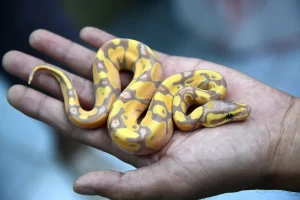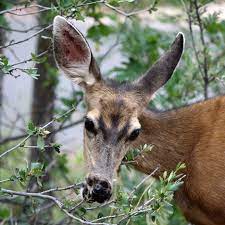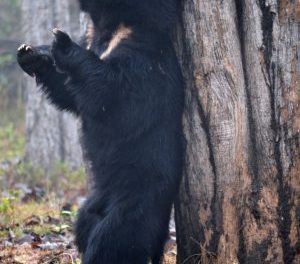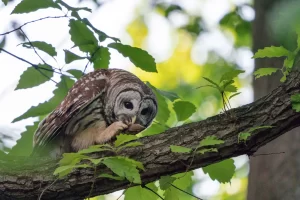The Ball python is a nonvenomous python species found in sub-Saharan Africa. This is the smallest of the African pythons. The name “ball python” refers to the animal’s tendency to curl into a ball when stressed or frightened. A common belief is that another name “royal python” comes from the legend that rulers in Africa, especially Cleopatra, would wear the python as jewelry. Ball pythons are stocky, with a relatively small head.

Ball python
The scales are smooth and both sexes have anal spurs on either side of the vent. The color pattern is typically black or dark brown with light brown or gold sides and dorsal blotches. The belly is white or cream that may include scattered black markings. However, those in the pet industries have, through selective breeding, developed many morphs (genetic mutations) with altered colors and patterns.
Read Pritish Kumar’s article, in which he tells about Python and some other related facts.
Distribution
Ball pythons are found in west Sub Saharan Africa from Senegal, Mali, Guinea-Bissau, Guinea, Sierra Leone, Liberia, Ivory Coast, Ghana, Benin, and Nigeria through Cameroon, Chad, and the Central African Republic to Sudan and Uganda.

Range of Ball python
They prefer grasslands, savannas, and sparsely wooded areas, and can also be found in agricultural land.
Description
The ball python is black, or albino and dark brown with light brown blotches on the back and sides. Its white or cream belly is scattered with black markings. It is a stocky snake with a relatively small head and smooth scales. It reaches a maximum adult length of 182 cm (6 ft 0 in). Males typically measure eight to ten subcaudal scales, and females typically measure two to four subcaudal scales. Females reach an average snout-to-vent length of 116.2 cm (45+3⁄4 in), a 44.3 mm (1+3⁄4 in) long jaw, an 8.7 cm (3+7⁄16 in) long tail and a maximum weight of 1.635 kg (3 lb 9.7 oz).

Ball python description
Males are smaller with an average snout-to-vent length of 111.3 cm (43+13⁄16 in), a 43.6 mm (1+23⁄32 in) long jaw, an 8.6 cm (3+3⁄8 in) long tail and a maximum weight of 1.561 kg (3 lb 7.1 oz). Both sexes have pelvic spurs on both sides of the vent. During copulation, males use these spurs for gripping females. Males tend to have larger spurs, and sex is best determined by manual eversion of the male hemipenes or inserting a probe into the cloaca to check the presence of an inverted hemipenis.
Habits and Lifestyle
Ball pythons are nocturnal and solitary creatures. Males tend to display more semi-arboreal behaviors, whilst females tend towards terrestrial behaviors. In dry months when it gets hot they hide in mammal burrows and other underground hiding places, where they can aestivate.
Ball pythons are known for their defense strategy that involves coiling into a tight ball when threatened, with their head and neck tucked away in the middle. In this state, they can literally be rolled around. In captivity, Ball pythons are considered good pets, with their relatively small size and placid nature making them easy to handle.
Diet and Nutrition
Ball pythons are carnivores. In the wild, their diet consists mostly of small mammals, such as African soft-furred rats, shrews, gerbils, and striped mice and birds. In captivity, they will accept common rats and mice, and some will eat chicks.
Mating Habits
Ball pythons are polygynandrous (promiscuous) which means that both males and females mate with multiple partners. They usually breed from mid-September through mid-November. Females lay 3 to 11 large, leathery eggs (4 to 6 are most common). Eggs are incubated by the female under the ground (via a shivering motion), and hatch after 55 to 60 days. Parental care of the eggs ends once they hatch, and the female leaves the offspring to fend for themselves.

Baby Ball python
Reproductive maturity is reached at 11-18 months for males, and 20-36 months for females. Age is only one factor in determining reproductive maturity and ability to breed; weight is the second factor. Males breed at 600 g or more, but in captivity are often not bred until they are 800 g (1.7 lb), although, in captivity, some males have been known to begin breeding at 300–400 g. Females breed in the wild at weights as low as 800 g though 1200 g or more in weight is most common; in captivity, breeders generally wait until they are no less than 1500 g (3.3 lb).
Population
Population threats
The biggest threat to Ball pythons is pet rade. These snakes are captured in thousands and exported to other countries. This may lead to local extirpation of the species. Ball pythons are also hunted for food and leather.
Population number
The IUCN Red List and other sources don’t provide the number of the Ball python total population size. Currently, this species is classified as Least Concern (LC) on the IUCN Red List.
Ecological niche
Ball pythons help to control populations of small mammals they prey on.
In culture
The ball python is particularly revered by the Igbo people in southeastern Nigeria, who consider it symbolic of the earth, being an animal that travels so close to the ground. Even Christian Igbos treat ball pythons with great care whenever they come across one in a village or on someone’s property; they either let them roam or pick them up gently and return them to a forest or field away from houses.

Ball python relationship with human
If one is accidentally killed, many communities on Igbo land still build a coffin for the snake’s remains and give it a short funeral. In northwestern Ghana, there is a taboo towards pythons as people consider them a savior and cannot hurt or eat them. According to folklore a python once helped them flee from their enemies by transforming into a log to allow them to cross a river.
Reference
https://animalia.bio/ball-python?environment=331










